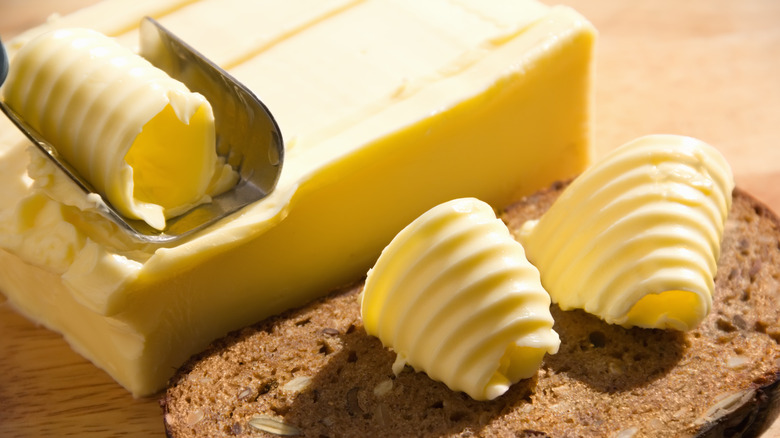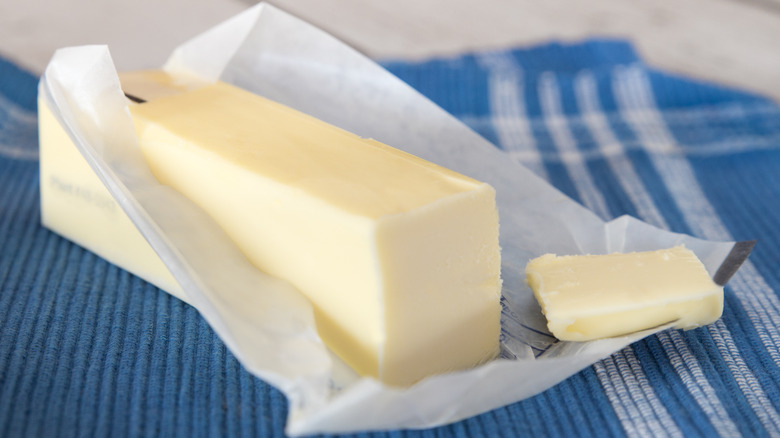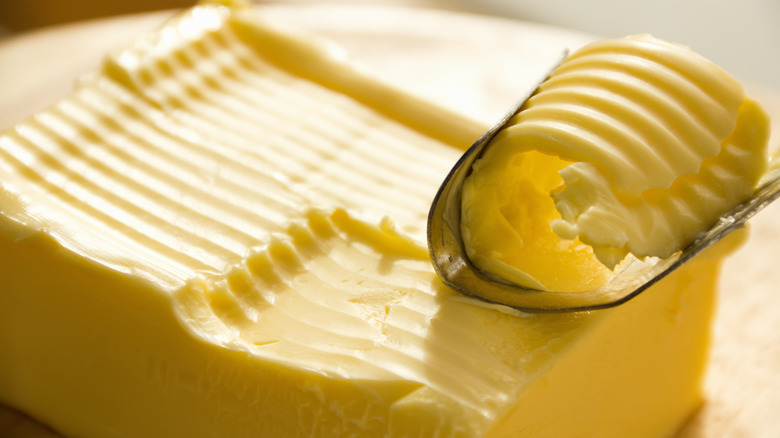The Difference Between Sweet Cream And Cultured Butter
There are numerous types of butter, but two of the most common are sweet cream and cultured. While both delicious and versatile, the two are very different. Despite what the name suggests, sweet cream butter isn't so named because it tastes sweet, but to distinguish it — a butter made from pasteurized cream — from the sour fermented cream destined to become cultured butter. The taste of sweet cream butter is muted and plain compared to the cultured varieties, whose creaminess is cut with a hint of tang.
Colloquially, you might hear folks refer to sweet cream butter as "American butter" and cultured butter as "European-style butter," as the latter is becoming more commonly available in the U.S. American or sweet cream butter has less butterfat, around 80%, while European or cultured butter is required to have at least 82%. Cultured butter is also churned longer, which helps give it a higher fat percentage, and it has a more yellow hue than sweet cream varieties. Due to the differences in fat content, each type of butter should be used for different types of cooking.
Sweet cream butter: The versatile choice
Sweet cream butter is made by pasteurizing fresh, raw cream and sterilizing it so it's safe for human consumption. The pasteurized cream is placed into a churner which begins to separate the fat molecules from the buttermilk. Then, the separated butterfat is blended with a salt brine for salted sweet cream butter, although salt also acts as a preservative (of course, this process is omitted for unsalted sweet cream butter). All sweet cream butter brands, salted or otherwise, tend to have a mild flavor and creamy texture.
Due to its lower smoke point, sweet cream butter is ideal for low-temperature cooking. But because it's widely accessible and relatively cheap, it's a great fat to use for just about any cooking method, including sauteing, frying, caramelizing, and saucing. Sweet cream butter is also ideal for baking recipes that usually ask for a lot of butter. It works perfectly in goods like bread, muffins, or cookies, where butter takes a secondary role in terms of flavor. You could also choose between regular sweet cream butter (which is salted) and unsalted sweet cream butter, although bakers usually prefer unsalted butter to better control the flavor.
Cultured butter: The rich topping
Cultured butter starts with cream that has been fermented for at least 24 hours with bacteria similar to those used in other cultured dairy products like sour cream or yogurt. The cultures in the cream give this butter a more savory and slightly tart flavor. Beyond this, it's made in basically the same way as sweet cream butter; one must churn, whip, or shake it until it separates and knead in cold water to free the remaining buttermilk. If you are in the mood to make your own cultured butter, all you have to do is reintroduce pasteurized heavy cream to a bacterial culture by combining heavy cream and cultured buttermilk and giving it a day to ferment.
The high fat content of cultured butter, along with its tartness, makes it great for baking butter-based pastries. Anything from pie crust to a croissant should be prepared with cultured butter over sweet cream butter. However, due to its high cost, we also suggest that you take advantage of its flavor by using it as a light spread on biscuits, pancakes, and scones. It would be a waste of money to use it for pan-frying, especially if your recipe calls for a fair bit of cooking fat.


